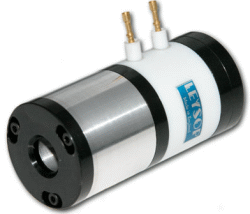Probably the most common and attractive mode of operation of an electro-optic Q-switch is in “pulsed quarter wave” mode. In this mode a quarter wave retardation plate is inserted between the Pockels cell and the rear cavity mirror. Light passing through the Pockels cell at zero applied voltage is unaffected but on passing twice through the wave-plate its polarization axis is rotated through 90°. In systems with correctly aligned polarizing gain media such as Nd:YVO4 the light is in the wrong polarization to receive significant gain and the cavity is operating at low Q.
With non-polarizing media such as Nd:YAG, an additional polarizing element must be inserted between the Pockels cell and the gain medium to force single polarization operation. When a pulse of the correct quarter wave retardation voltage is applied to the Pockels cell, it introduces a double pass polarization axis rotation of a further 90° and the overall effect is of no polarization rotation, hence the cavity is switched rapidly to a high Q condition and the medium is Q-switched.

This simple approach has several advantages over other techniques, notably, the operation of the Pockels cell at the lower quarter wave voltage (using one quarter the electrical power of a half wave switching system) and no d.c. voltage is applied to the Pockels cell which extends its operating lifetime.
However, the drawback is the additional effort required to mount and align the wave-plate and (if necessary) the additional polarizing element. With these pre-aligned and integrated onto the Pockels cell by Leysop, the device offers a considerably easier way to obtain the advantages of pulsed quarter wave switching.
High quality low insertion loss wave-plates and Brewster polarizers ensure that your system operates at its optimum and the Brewster polarizer mounting acts as an effective beam dump for the rejected light, thus simplifying the handling of stray light.
